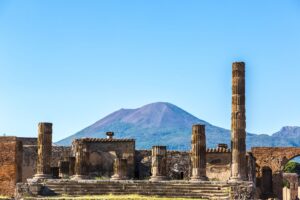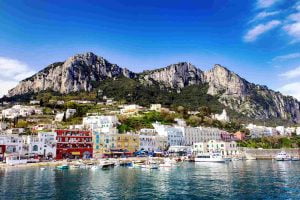Italy, Greek Isles and Turkey Cruise on the Sun Princess Itinerary
DAY 1 – Civitavecchia (for Rome), Italy
Your gateway to the Eternal City, Civitavecchia has served as Rome’s seaport since the 13th century. The port has a long and venerable history. The emperor Trajan built a pleasure villa near the modern city, while Bernini and Michelangelo designed the harbor fortifications. Yet the Eternal City eternally beckons. The ancient capital of the Western World and the center of Christianity for nearly 2,000 years, Rome provides an inexhaustible feast. Visit the ruins of the Forum, view the splendors of the Sistine Chapel, or climb the Spanish Steps, once the heart of Rome’s Bohemian Quarter. Rome has been a magnet luring the world’s greatest artists, architects, and philosophers since the days of the Caesars.
Day 2– Naples, Italy (for Capri & Pompeii)
Italy’s third-largest city, Naples is a bustling metropolis famed for it stately buildings, crowded streets, pizza – and notoriously bad traffic. However, this beautiful city is rich in centuries-old culture and customs. Naples is also your gateway to the Isle of Capri, the fabled Amalfi Coast and the ruins of Pompeii, buried in ash by the cataclysmic eruption of Mt. Vesuvius in 79 A.D.
Day-3– At sea
Day 4-Crete (Chania), Greece
Weaving a tapestry of awe and wonder, Chania is a centuries-old mix of Minoan myths, well-preserved Venetian mansions, a mesmerizing Old Town complete with labyrinthine passageways, and atmospheric Kastelli Hill, once the site of a Roman acropolis. But Chania may be best known as the gateway to the breathtaking 4,000 year-old Minoan ruins at Knossos, home of the legendary King Minos and the part man and part bull known creature as the Minotaur. And around every corner of this idyllic area you’ll find picturesque villages, breathtaking views and architectural wonders that will remain with you for a lifetime.
Day 5– At Sea
Day 6-Kusadasi, Turkey (for Ephesus)
In Kusadasi, whitewashed stone houses rise in tiers behind the market district. The palm-lined esplanade is the center of town life, with thousands of merchants offering wares to rival the Grand Bazaar in Istanbul.
Day 7 – Mykonos, Greece
Thanks to its proximity to the mainland, Mykonos was one of the first Greek islands to become an international travel destination. During the late ’60s and early ’70s, Mykonos was famed as a haunt for the rich. The island’s nightlife – then and now – was a glittering whirl of colored lights, music, and parties. But there’s another side to Mykonos – the neighboring island of Delos. In classical mythology, Delos was the birthplace of Apollo and his twin sister Artemis. Travelers to Delos can stroll among the island’s vast ruins, which include three temples consecrated to the Sun God and the famed Lions Walk.
Day 8 -Athens (Piraeus), Greece
The past maintains a vibrant presence in the cradle of Western civilization. Atop the Acropolis, the serene Parthenon sails above the commotion of the modern city. The tragedies of Aeschylus, Sophocles, and Euripides were performed in the Theater of Dionysus at the foot of the Acropolis. On Pnyx Hill, citizens of a fledgling democracy gathered to cast their votes on Athens’ destiny. Then there is the hustle and bustle of the modern city, a metropolis of 4.5 million that spreads out from the foot of Mt. Lycabettus and across the plain. Packed with busy shops and lively tavernas, modern Athens is a colorful counterpoint to classical Greece.



